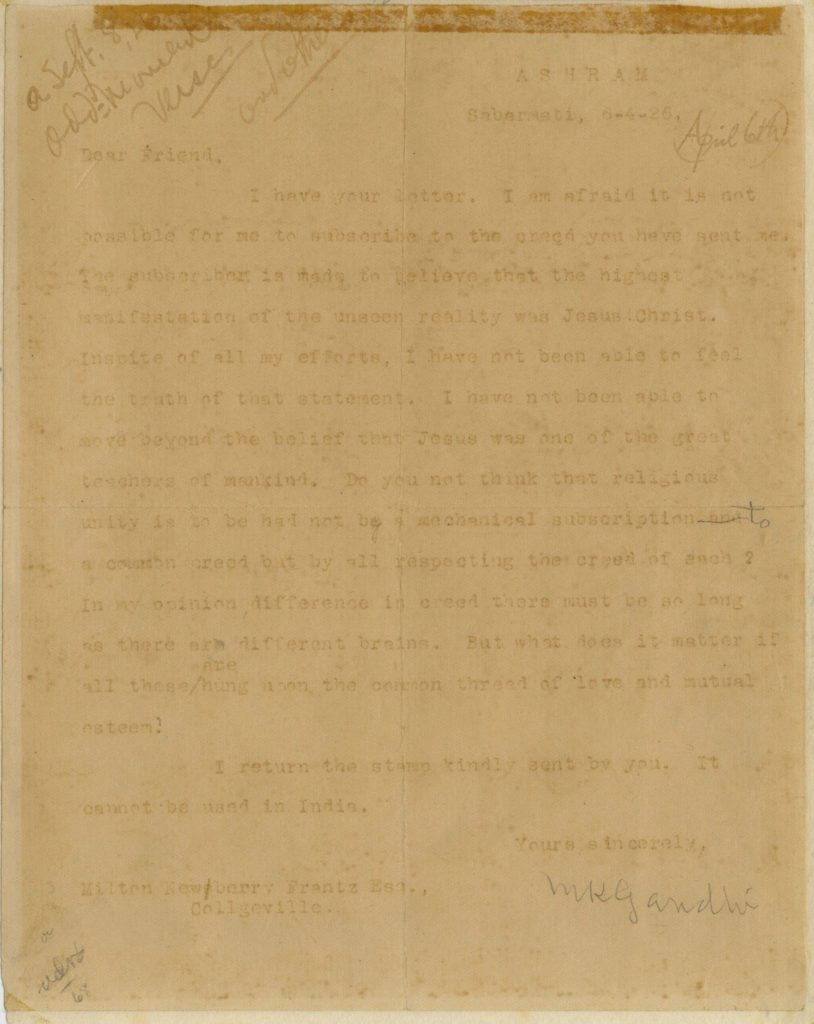Gandhi, Writing that “Jesus was one of the great teachers of mankind,” Concludes That “religious unity is to be had not by a mechanical subscription to a common creed but by all respecting the creed of each”

“The subscriber is made to believe that the highest manifestation of the unseen reality was Jesus Christ. In spite of all my efforts, I have not been able to feel the truth of that statement. I have not been able to move beyond the belief that Jesus was one of the great teachers of mankind.”
One of the finest letters of Gandhi to reach the market and the only letter we could find mentioning Jesus ever having been offered for sale
Gandhi hoped to win people over by changing their hearts and minds, and advocated non-violence in all things. He himself remained a committed Hindu throughout his...
One of the finest letters of Gandhi to reach the market and the only letter we could find mentioning Jesus ever having been offered for sale
Gandhi hoped to win people over by changing their hearts and minds, and advocated non-violence in all things. He himself remained a committed Hindu throughout his life, but was understanding of all faiths though critical of what he saw as the hypocrisy of organized religion. At 19 years old, after barely passing his matriculation exam, he eagerly took the opportunity to travel to Britain to become a barrister. In Britain, he met with Theosophical Society members, who encouraged him to look more closely at Hindu texts and especially the Bhagavad Gita, which he later described as a comfort to him. In doing so, he developed a greater appreciation for Hinduism, and also began to look more closely at other religions, being particularly influenced by Jesus’s Sermon on the Mount, and later on by Leo Tolstoy.
When he returned to India, his immediate problem was to settle his small band of relatives and associates in an ashram, which was a “group life lived in a religious spirit”. His ashram was a small model of the whole moral and religious ideal. It did not enforce on its inmates any theology or ritual, but only a few simple rules of personal conduct.
In 1926, a religious elder in the United States, Milton Newberry Frantz, wrote to Gandhi, asking him to read a recent publication he had written with verses about Christianity. In his response, Gandhi reveals how much effort he has put into seeing Christianity and Jesus from the perspective of a Christian, and states the central tenet of his feelings about religions around the world. He also reveals that he believes Jesus was a great teacher.
Typed letter signed, Sabarmati Ashram, Ahmedabad, Gujarat, April 6, 1926, to Milton Newberry Frantz. “Dear Friend, I have your letter. I am afraid it is not possible for me to subscribe to the creed you have sent me. The subscriber is made to believe that the highest manifestation of the unseen reality was Jesus Christ. In spite of all my efforts, I have not been able to feel the truth of that statement. I have not been able to move beyond the belief that Jesus was one of the great teachers of mankind. Do you not think that religious unity is to be had not by a mechanical subscription to a common creed but by all respecting the creed of each? In my opinion, difference in creed there must be so long as there are different brains. But what does it matter if all these are hung upon the common thread of love and mutual esteem?
“I return the stamp kindly sent by you. It cannot be used in India.”
This is one of the finest letters on religion that Gandhi ever wrote, not merely dealing specifically with Christianity, but going even further to espouse a universalist doctrine of respect for all faiths and beliefs.
Our research discloses no other letter of Gandhi mentioning Jesus to have ever reached the public market. It has been in a private collection since the 1960s. Lightening to printed portion from Gandhi’s ink. Signature unaffected.

Frame, Display, Preserve
Each frame is custom constructed, using only proper museum archival materials. This includes:The finest frames, tailored to match the document you have chosen. These can period style, antiqued, gilded, wood, etc. Fabric mats, including silk and satin, as well as museum mat board with hand painted bevels. Attachment of the document to the matting to ensure its protection. This "hinging" is done according to archival standards. Protective "glass," or Tru Vue Optium Acrylic glazing, which is shatter resistant, 99% UV protective, and anti-reflective. You benefit from our decades of experience in designing and creating beautiful, compelling, and protective framed historical documents.
Learn more about our Framing Services








































































































